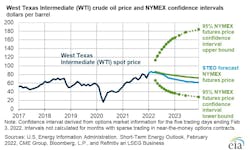In the February Short-Term Energy Outlook (STEO), the US Energy Information Administration (EIA) forecasts the Brent crude oil spot price will average $83/bbl in 2022, $8/bbl more than its January STEO forecast.
“The higher price forecast partly reflects a reduction in our forecast of OECD inventories in first-half 2022. Although we continue to expect crude oil prices to decline beginning in March, crude oil price increases over the past month mean that declines will begin from a higher price level, which also contributes to higher crude oil price levels in our forecast throughout 2022. The increase in crude oil prices in the forecast also results in higher prices for gasoline and diesel fuel in 2022 compared with last month’s forecast. It also results in more US crude oil production compared with last month’s forecast,” EIA explained.
Brent crude oil spot prices averaged $87/bbl in January, a $12/bbl increase from December 2021. Crude oil prices have risen steadily since mid-2020 as result of consistent draws on global oil inventories, which averaged 1.8 million b/d from third-quarter 2020 through end 2021. EIA estimate global oil inventories fell further in January—compared with its expectation of an increase in last month’s STEO—and that commercial inventories in the OECD ended the month at 2.68 billion bbl, which is the lowest level since mid-2014.
A major contributing factor to the low global oil inventories is less production from some OPEC+ countries than targeted amounts due to operational difficulties. During fourth-quarter 2021, EIA estimates that the 10 OPEC countries subject to production targets produced less than those targets by a combined average of more than 600,000 b/d.
Oil prices have also risen as result of heightened market concerns about the possibility of oil supply disruptions, notably related to tensions regarding Ukraine, paired with receding market concerns that the Omicron variant of COVID-19 will have widespread effects on oil consumption, EIA noted.
“More recently, geopolitical conflicts have also put upward pressure on oil prices. Prices can be more sensitive to concerns about supply disruptions during periods of low inventories. Tensions related to Ukraine have increased market concerns about the possibility of oil supply disruptions. In the Middle East, several missile attacks on Abu Dhabi—one of which hit a fuel storage facility— has added to uncertainties for future oil supply, which may also be affected by political unrest in Libya and Kazakhstan,” EIA said.
EIA expects Brent prices will average $90/bbl in February as continuing draws in global oil inventories in the forecast keep crude oil prices near current levels in the coming months. However, it expects downward price pressures will emerge midyear as growth in oil production from OPEC+, the US, and other non-OPEC countries outpaces slowing growth in global oil consumption. This dynamic leads to rising global oil inventories from second-quarter 2022 through end 2023, and EIA forecasts the Brent spot price will fall to an average of $87/bbl in second-quarter 2022 and $75/bbl in fourth-quarter 2022. EIA expects the Brent price will average $68/bbl for all of 2023. However, low inventory levels create an environment for potentially heightened crude oil price volatility and potential risk for prices to rise significantly if supply growth does not keep pace with demand growth.
Meantime, global supply chain disruptions have also likely exacerbated inflationary price effects across all sectors in recent months. How central banks’ policies against inflation may affect economic growth and oil prices during the forecast period.
EIA estimates that 99 million b/d of petroleum and liquid fuels was consumed globally in January 2022, an increase of 6.6 million b/d from January 2021. Global consumption of petroleum and liquid fuels is expected to average 100.6 million b/d for all of 2022, up 3.5 million b/d from 2021, and more than the 2019 average of 100.3 million b/d. Global consumption of petroleum and liquid fuels will increase by 1.9 million b/d in 2023.
US regular gasoline retail prices averaged $3.31/gal in January, unchanged from December 2021 and up 98¢/gal from January 2021. Retail diesel prices averaged $3.72/gal in January, up 8¢/gal from December and up $1.04/gal from last January.
“Product prices have risen compared with year-ago levels because of rising crude oil prices and high refining margins. We expect diesel prices will average $3.49/gal from second- 2022 quarter through fourth-quarter 2022. The forecast decline in prices reflects our expectation of falling crude oil prices, particularly in the second half of 2022, as well as lower refining margins as refineries increase throughputs in the coming months,” EIA said.
US crude oil production reached almost 11.8 million b/d in November 2021 (the most recent monthly historical data point), the most in any month since April 2020. EIA forecasts production will rise to an average of 12 million b/d in 2022 and 12.6 million b/d in 2023, which would be record-high production on an annual-average basis. The previous annual average record of 12.3 million b/d was set in 2019.
